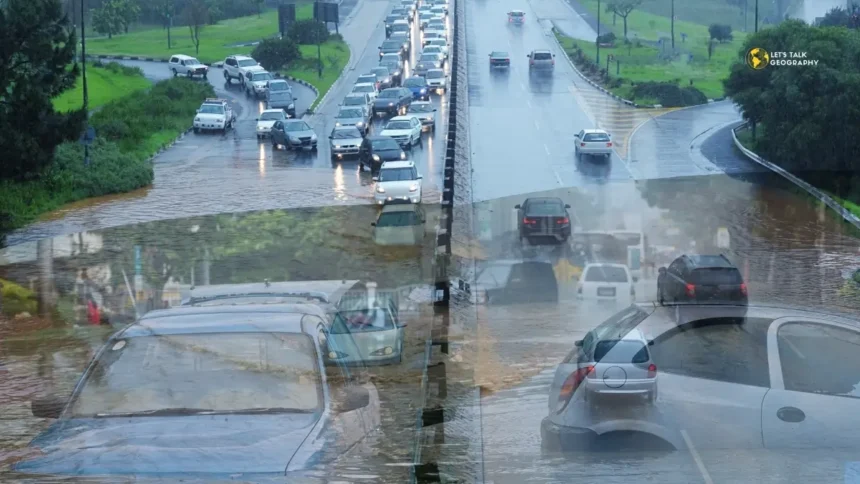Introduction to Climate Change on Coastal Flooding in U.S. Cities:
Have you noticed that floods happen more often in coastal cities? Climate change is making coastal flooding a growing problem in the U.S., affecting everything from infrastructure to housing markets. But why is this happening, and what does the future hold for these vulnerable cities? According to the National Oceanic and Atmospheric Administration (NOAA), sea levels have risen about 8 inches since 1880, with rates accelerating rapidly in recent years.
This sea-level rise, combined with more intense storms and shifting weather patterns, amplifies the impact of climate change on coastal flooding in U.S. cities. In this article, we’ll explore how climate change is worsening coastal flooding, which cities are at the highest risk, and what steps can be taken to mitigate these challenges.
| Climate Change Factor | Description | Impact on Flooding |
| Sea Level Rise | Rising global sea levels due to melting ice and thermal expansion | Increased flood risks |
| Stronger Storms | More intense hurricanes and storms due to warmer ocean temperatures | Higher storm surges |
| Shifting Weather Patterns | Unpredictable rainfall patterns leading to extreme precipitation | Flash flooding |
1. The Role of Sea Level Rise in Coastal Flooding
How Rising Seas Exacerbate Flooding
The most direct consequence of climate change on coastal flooding is sea-level rise. As glaciers melt and the ocean absorbs more heat, the water expands, causing global sea levels to rise. The U.S. Environmental Protection Agency (EPA) warns that coastal areas in the U.S. could see an additional 1 to 4 feet of sea-level rise by 2100. This rise in sea level means that even small storms can cause large-scale flooding, especially during high tides.
Key Examples:
- Miami, Florida: Often called “ground zero” for sea-level rise, Miami is already experiencing frequent “sunny day flooding,” where high tides cause flooding without storm activity.
- New York City, New York: After Superstorm Sandy caused billions in damages, NYC has invested heavily in flood defenses. However, with sea levels projected to rise by up to 11 inches by 2050, the city remains vulnerable to future storm surges.
Also Read: How Miami is Battling Sea-Level Rise Due to Climate Change?
Impact on Infrastructure
Coastal cities are repeatedly damaged by saltwater intrusion and flooding, causing drainage systems, roads, and buildings to struggle to keep up. As waters rise, this leads to higher costs for repairs and upgrades.
2. More Intense Storms and Their Impact on Coastal Flooding in U.S. Cities
Warmer Oceans, Stronger Storms
Climate change has also led to warmer ocean temperatures, fueling stronger and more frequent hurricanes. A warmer atmosphere holds more moisture, which results in heavier rainfall during storms. This combination of factors leads to more extreme storm surges, which can inundate coastal areas, even those with robust flood defenses.
Key Examples:
- New Orleans, Louisiana: Already vulnerable due to its low-lying geography, New Orleans faces increasing threats from stronger hurricanes. Hurricanes like Katrina and Ida have shown how devastating storm surges can be when combined with heavy rainfall.
- Houston, Texas: Although Houston is inland, its proximity to the coast makes it vulnerable to hurricanes and extreme rainfall. Hurricane Harvey in 2017 dumped over 60 inches of rain in some areas, causing catastrophic flooding.
Impact on Communities
As storms become stronger, the cost to communities rises. Coastal cities face physical and economic losses from business disruptions, property damage, and costly recovery efforts. The more intense these storms become, the more challenging and expensive it is for cities to bounce back.
Also Read: Hidden Danger Threatening Coastal U.S. Cities
3. Shifting Weather Patterns and Increased Flood Risk
Unpredictable Precipitation Patterns
Climate change is causing shifts in weather patterns, making extreme precipitation events more frequent and severe. This means heavier rains and flash flooding in coastal regions, even outside storm events. Cities that may not have previously experienced frequent flooding are increasingly vulnerable to coastal and inland flood risks.
Examples:
- Charleston, South Carolina: The city has seen a 300% increase in high-tide flooding events in recent decades. These events are exacerbated by heavy rainfall, which overwhelms the city’s drainage systems.
- San Francisco, California: While traditionally not considered at risk for coastal flooding in U.S. cities, shifting weather patterns bring stronger Pacific storms and increased rainfall, causing erosion and flood concerns in low-lying areas.
Impact on Property Values
As areas experience more frequent flooding, property values in these regions are beginning to drop. Prospective buyers are increasingly cautious about purchasing homes in flood-prone areas, leading to declining demand. This trend and rising insurance costs could have long-term economic impacts on coastal real estate markets.
How U.S. Cities Are Responding to Coastal Flooding
Coastal cities across the U.S. are taking action to mitigate the impact of climate change and coastal flooding. Some of the common strategies include:
- Building Sea Walls: Cities like New York and Miami are investing in massive sea walls to keep rising waters at bay. For example, New York’s East Side Coastal Resiliency Project aims to protect parts of Manhattan from future flooding.
- Restoring Wetlands: Wetlands act as natural buffers against storm surges and rising sea levels. Cities like New Orleans are working to restore coastal wetlands as part of their flood protection strategies.
- Upgrading Drainage Systems: Improved drainage systems can help reduce the impacts of heavy rainfall and high tides. In Charleston, new pumps and elevated streets are helping to mitigate tidal flooding.
- Zoning and Land Use Changes: Cities are beginning to rethink land use in flood-prone areas. Some consider retreating from the most vulnerable zones and preventing new development.
Key Takeaway
Climate change is accelerating coastal flooding in U.S. cities through sea-level rise, more intense storms, and unpredictable weather patterns. While cities invest in solutions, the scale of the problem continues to grow, requiring more robust action at the local, state, and federal levels.
Conclusion:
The effects of climate change on coastal flooding in U.S. cities are becoming increasingly evident. As sea levels rise, storms intensify, and rainfall patterns shift, cities along the U.S. coastline face more frequent and severe flooding. While many cities are implementing measures to adapt to these changes, the cost and complexity of these adaptations will continue to grow. The flooding impact of climate change isn’t just a future concern; it’s already here, reshaping how we live, work, and protect our coastal communities. For long-term resilience, it’s clear that a combination of local actions and global climate mitigation efforts will be essential.
How does climate change increase coastal flooding?
Climate change increases coastal flooding primarily through sea-level rise and stronger storms. Warmer oceans fuel more intense storms while melting ice caps and expanding seawater lead to higher sea levels.
Which U.S. cities are most at risk for coastal flooding?
Cities like Miami, New York, New Orleans, Charleston, and San Francisco are among the most vulnerable to coastal flooding due to their geographic location and rising sea levels.
What are cities doing to combat the flooding impact of climate change?
Cities invest in infrastructure like sea walls, improve drainage systems, restore natural wetlands, and revise zoning laws to prevent development in flood-prone areas.
How is sea-level rise contributing to “sunny day” flooding?
“Sunny day” flooding occurs when high tides and rising sea levels cause flooding even without storms. As sea levels rise, cities like Miami are increasingly experiencing these events.
Can coastal cities fully protect themselves from climate change?
While cities can take steps to reduce the impact of climate change, complete protection may be realistic with significant global efforts to reduce greenhouse gas emissions.





